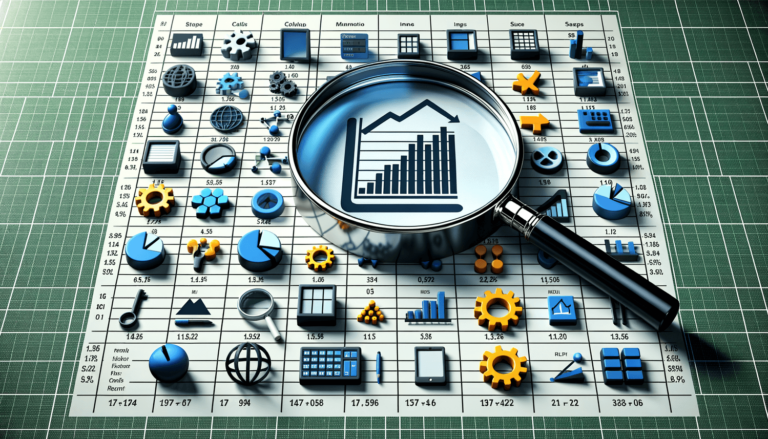

Microsoft Excel is a powerful spreadsheet tool that comes with many features to help you perform data analysis. One of the most fundamental calculations in statistics is correlation. Correlation measures the degree of association between two variables. It is commonly used to determine how strongly two variables are related to each other. In this blog post, we will show you how to perform correlation in Excel using a simple step-by-step method. Whether you are a beginner or an advanced Excel user, this post will provide you with a concise and precise overview of how to do correlation in Excel.
Excel provides a variety of statistical functions to help you analyze your data, including correlation. Correlation measures the relationship between two variables. Excel supports two types of correlation calculations, Pearson’s correlation and Spearman’s correlation.
Before calculating correlation in Excel, you need to organize your data. Arrange the data in a table with the two variables you want to analyze in separate columns. Make sure the data is organized in a consistent and logical way.
To calculate correlation in Excel, use the CORREL function. This function calculates the Pearson’s correlation coefficient between two variables. The formula for the CORREL function is:
=CORREL(array1,array2)
Where array1 and array2 are two sets of values you want to analyze.
To calculate Spearman’s correlation coefficient, use the SPEARMAN function. The formula for the SPEARMAN function is:
=SPEARMAN(array1,array2)
The correlation coefficient ranges from -1 to 1, where -1 indicates a perfect negative relationship, 0 indicates no relationship, and 1 indicates a perfect positive relationship. A correlation coefficient of 0.5 or higher is generally considered a strong correlation.
Correlation is a fundamental statistical calculation that measures the relationship between two variables. By following the steps outlined in this post, you can calculate correlation in Excel quickly and easily. Whether you’re analyzing sales data or conducting a scientific study, understanding correlation can help you draw meaningful conclusions from your data.
Correlation is a useful statistical tool that can help identify patterns and relationships in your data. However, it is important to note that correlation does not prove causation. Just because two variables are strongly correlated does not necessarily mean that one causes the other. Correlation only measures the strength of the relationship between two variables and cannot determine the cause.
Correlation can be used in a variety of fields, including finance, engineering, and social sciences. For example, finance professionals may use correlation to analyze the relationship between two stocks, while engineers can use correlation to study the relationship between two physical properties.
While correlation provides valuable insights into the relationship between two variables, there are some limitations to keep in mind. One limitation is that correlation cannot be used to determine causation. Just because two variables are strongly correlated does not mean that one causes the other.
Another limitation is that correlation assumes linear relationships between the variables. If the relationship between two variables is non-linear, correlation may not accurately reflect the strength of the relationship.
Correlation is a powerful statistical tool that can help you identify patterns and relationships in your data. Excel provides an easy-to-use formula for calculating correlation, allowing you to analyze your data quickly and easily. By following the steps outlined in this post, you can use correlation to gain valuable insights into your data.
However, it is important to remember that correlation only measures the strength of the relationship between two variables and cannot determine causation. Additionally, correlation assumes linear relationships between variables, and may not accurately reflect the relationship between non-linear data.
Overall, correlation is a valuable tool for data analysis, but it is important to use it in conjunction with other methods and to understand its limitations.
Here are some frequently asked questions about calculating correlation in Excel.
Correlation in Excel refers to the measurement of the relationship between two variables. Specifically, correlation measures the degree to which two variables are related to each other. This metric can help identify patterns and relationships in your data that may not be immediately apparent.
Pearson correlation measures the linear relationship between two variables, where both variables are assumed to be normally distributed. Spearman correlation, on the other hand, measures the monotonic relationship between two variables, which is a more general relationship that includes both linear and nonlinear associations.
The correlation coefficient measures the strength and direction of the relationship between two variables. A coefficient of -1 implies a perfect negative correlation, meaning that as one variable increases, the other decreases. A coefficient of 1 indicates a perfect positive correlation, where both variables increase together. A coefficient of 0 indicates no correlation between the variables.
One of the main limitations of correlation analysis is that it cannot be used to establish causality. Just because two variables are correlated does not mean that one variable causes the other. Correlation also assumes that the relationship between the variables is linear, which may not always be the case. Additionally, correlation analysis is vulnerable to outliers, or extreme values that may skew the results.
Correlation can be used in a variety of business settings, from financial analysis to customer behavior analysis. For example, you could use correlation analysis to determine if there is a relationship between a sales team’s performance and the number of leads generated. Similarly, you could use correlation analysis to determine if there is a relationship between customer satisfaction and customer retention rates.
Explore the world of Microsoft PowerPoint with LearnPowerpoint.io, where we provide tailored tutorials and valuable tips to transform your presentation skills and clarify PowerPoint for enthusiasts and professionals alike.

Your ultimate guide to mastering Microsoft Word! Dive into our extensive collection of tutorials and tips designed to make Word simple and effective for users of all skill levels.

Boost your brand's online presence with Resultris Content Marketing Subscriptions. Enjoy high-quality, on-demand content marketing services to grow your business.
